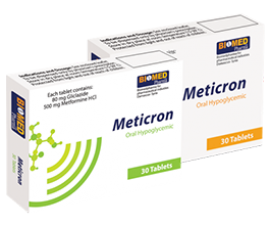Meticron
- Gliclazide + Metformin HCI
Each tablet contains:
- Gliclazide 80 mg
- Metformin HCI 500 mg
Leaflet
Meticron
COMPOSITION
Each Tablet contains :
Gliclazide 80 mg
Metformin Hydrochloride 500 mg
Mechanism of action:
Meticron combines two hypoglycemic agents with complementary mechanisms of action
Gliclazide : β –cells- selective sulfonylurea which provides global metabolic and vascular treatment of type 2 diabetic patients (Non-insulin dependent diabetes mellitus).It reduces blood glucose levels by correcting both defective insulin secretion and peripheral insulin resistance. This occurs by closure of K+ channels in β -cells of pancreas. Subsequently, Ca2+ channel opens leading to increase in intracellular calcium and induction of insulin release. Gliclazide also increases the sensitivity of β -cells to glucose. Gliclazide restores peripheral insulin sensitivity such as decreasing hepatic glucose production and increasing glucose clearance. It has anti-platelet adhesive activity and reduces level of free radicals, thereby preventing vascular complications.
Metformin : An antihyperglycemic agent which improves glucose tolerance in patients with type 2 diabetes, lowering both basal and postprandial plasma glucose.. Metformin decreases hepatic glucose production, decreases intestinal absorption of glucose, and improves insulin sensitivity by increasing peripheral glucose uptake and utilization. With metformin therapy, insulin secretion remains unchanged while fasting plasma insulin levels and day-long plasma insulin response may actually decrease.
PHARMACOKINETICS
Gliclazide: Single oral dose of gliclazide, 40 to 120 mg results in a Cmax of 2.2 to 8 mg/l within 2 to 8 hours. Steady state concentrations are achieved after 2 days of administration of 40-120 mg of gliclazide. Administration of gliclazide with food reduces Cmax and delays Tmax. The volume of distribution is low due to extensive protein binding (85-97%). The half life of gliclazide varies from 8.1 - 20.5 hours after single dose administration. Gliclazide is extensively metabolised to 7 metabolites predominantly excreted in the urine, the most abundant being the carboxylic acid derivative; 60-70% of the dose is excreted in the urine and 10-20% in the feces.
Metformin has absolute oral bioavailability of 50-60%. GIT absorption is complete within 6 hrs of ingestion . Metformin is rapidly distributed in body after absorption. Steady state plasma concentrations are reached within 24-48 hours. The renal elimination of metformin is biphasic. 95% of the absorbed metformin is eliminated during primary elimination phase having half-life of 6 hours. Rest of the 5% is eliminated during slow terminal elimination phase with mean half-life of 20 hours. Metformin is not bound to plasma proteins, 40-60% of the dose is recovered as unchanged drug in urine with a further 30% recovered as unchanged drug in feces.
INDICATIONS
Meticron is indicated in obese and non- obese type 2 diabetic patients (Non-insulin dependent diabetes mellitus) with inadequate glycemic control with diet alone .
CONTRAINDICATIONS
diabetes type 1( Insulin-dependent diabetes mellitus), renal or hepatic failure, alcoholism, NIDDM complicated by severe ketosis and acidosis, diabetic pre-coma and coma, any condition associated with Hypoxemia ( chronic obstructive pulmonary disease, acute myocardial infraction, cardiac failure), pregnancy, known hypersensitivity to any of the ingredients.
DRUG INTERACTIONS
-Diuretics, barbiturates, phenytoin, rifampicin, corticosteroids, estrogens, estroprogestogens and pure progestogens may reduce the glycaemic control.
-Its hypoglycaemic action may be potentiated by Salicylates, phenylbutazone, sulphonamides, beta-blockers, clofibrate , vitamin k antagonist, allopurinol, theophylline, caffeine and monoamine oxidase inhibitors.
- Concomitant administration of miconazole, perhexiline or cimetidine with gliclazide may result in hypoglycaemia.
-Concomitant administration of gliclazide with agents that increase blood glucose levels should not be considered without careful monitoring of blood glucose levels to avoid hyperglycaemia.
-Acarbose and guar gum has been shown to decrease the oral bioavailability of metformin significantly.
ADVERSE REACTIONS
Gastrointestinal disturbances - Nausea, diarrhoea, gastric pain, constipation, vomiting, metallic taste in mouth.
Dermatological effects - Rash, pruritus, urticaria, erythema and flushing.
Miscellaneous - Headache and dizziness.
PRECAUTIONS
-Gliclazide appears to be associated with a low incidence of hypoglycaemia or hypoglycemic symptoms ( headache, shakiness, agitation ).
- Impaired gastrointestinal absorption of vitamin B12 and folic acid has been associated with long term metformin therapy.
OVERDOSAGE AND TREATMENT
Hypoglycaemia may occur in case of an overdosage. In the event of an overdosage, gastric lavage should be performed and correction of hypoglycaemia should be attempted by intravenous adminsitration of hypertonic glucose (10 or 30%) with continued monitoring of the patient's blood glucose levels.
DOSAGE AND ADMINISTRATION
1-2 tablets once or twice daily with meals to a maximum of 4 tablets/day.
PRESENTATION
Box of 30 tablets

